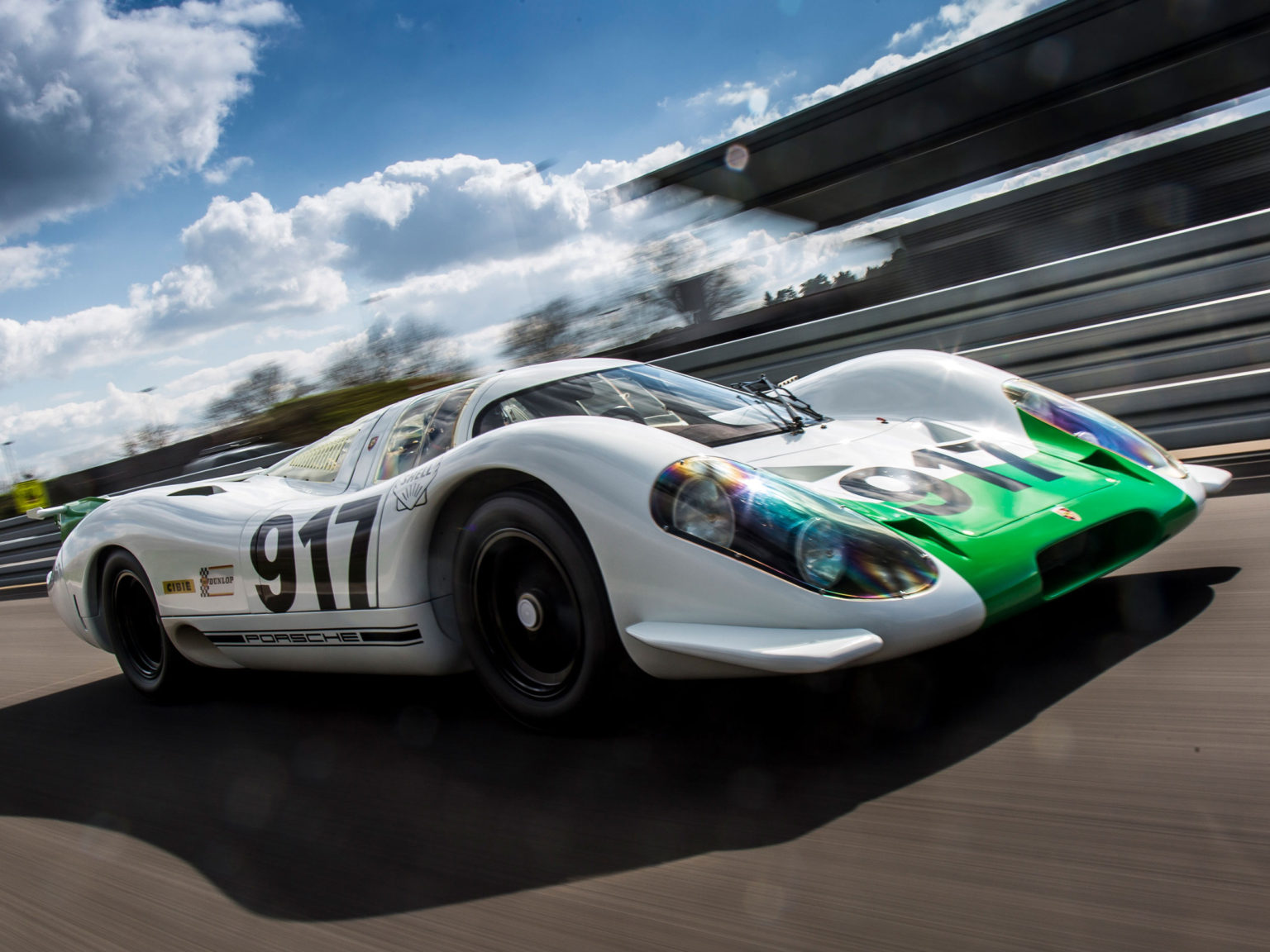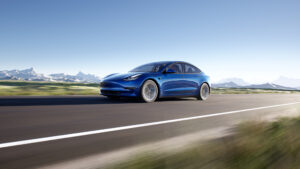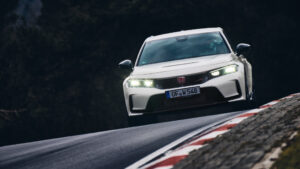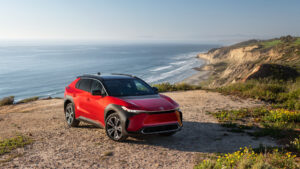Porsche is celebrating its past with a recent post on their newsroom site featuring five different iconic liveries sported by the 917 during races. The liveries sport famous designs including looks including Martini, Gulf, and one known as the “Pink Pig”. Below are the featured liveries and the stories behind them.
917 in Gulf Livery
Photo courtesy of Dr. Ing. h.c. F. Porsche AG
The Gulf-liveried Porsche 917 is most popular because of its appearance in the Steve McQueen film “Le Mans”. The car used in the film sold for $14 million in 2017, which was, a sum making it the most expensive Porsche in the world.
917 in Gulf livery
Photo courtesy of Dr. Ing. h.c. F. Porsche AG
The Gulf-liveried Porsche 917 is most popular because of its appearance in the Steve McQueen film “Le Mans”. The car used in the film sold for $14 million in 2017, which was, a sum making it the most expensive Porsche in the world.
917 in Gulf livery
Photo courtesy of Dr. Ing. h.c. F. Porsche AG
The Gulf-liveried Porsche 917 is most popular because of its appearance in the Steve McQueen film “Le Mans”. The car used in the film sold for $14 million in 2017, which was, a sum making it the most expensive Porsche in the world.
917-001
Photo courtesy of Dr. Ing. h.c. F. Porsche AG
Despite it’s race-like livery, the 917-001 was never a race car. The first Porsche 917, chassis number 001, was completed in March 1969, just two days before a press event announcing the arrival of new Porsche Group 4 sports cars is set to occur. The following month the model received its homologation certification, meaning that it was approved for racing. However, instead of racing, the 001 became a show car and a test vehicle.
By the time the car made its way to the German International Motor Show in Frankfurt in September 1969, it had been repainted from a white body and green front to an orange and white paint scheme.
In 2017, in preparation for its “50 Years of the 917” anniversary event, the Porsche Museum decided to restore the 917-001 to its original appearance. Restoration as completed in 2019 and was commemorated with an appearance on the track at Goodwood.
917-001
Photo courtesy of Dr. Ing. h.c. F. Porsche AG
Despite it’s race-like livery, the 917-001 was never a race car. The first Porsche 917, chassis number 001, was completed in March 1969, just two days before a press event announcing the arrival of new Porsche Group 4 sports cars is set to occur. The following month the model received its homologation certification, meaning that it was approved for racing. However, instead of racing, the 001 became a show car and a test vehicle.
By the time the car made its way to the German International Motor Show in Frankfurt in September 1969, it had been repainted from a white body and green front to an orange and white paint scheme.
In 2017, in preparation for its “50 Years of the 917” anniversary event, the Porsche Museum decided to restore the 917-001 to its original appearance. Restoration as completed in 2019 and was commemorated with an appearance on the track at Goodwood.
917-001
Photo courtesy of Dr. Ing. h.c. F. Porsche AG
Despite it’s race-like livery, the 917-001 was never a race car. The first Porsche 917, chassis number 001, was completed in March 1969, just two days before a press event announcing the arrival of new Porsche Group 4 sports cars is set to occur. The following month the model received its homologation certification, meaning that it was approved for racing. However, instead of racing, the 001 became a show car and a test vehicle.
By the time the car made its way to the German International Motor Show in Frankfurt in September 1969, it had been repainted from a white body and green front to an orange and white paint scheme.
In 2017, in preparation for its “50 Years of the 917” anniversary event, the Porsche Museum decided to restore the 917-001 to its original appearance. Restoration as completed in 2019 and was commemorated with an appearance on the track at Goodwood.
917-001
Photo courtesy of Dr. Ing. h.c. F. Porsche AG
Despite it’s race-like livery, the 917-001 was never a race car. The first Porsche 917, chassis number 001, was completed in March 1969, just two days before a press event announcing the arrival of new Porsche Group 4 sports cars is set to occur. The following month the model received its homologation certification, meaning that it was approved for racing. However, instead of racing, the 001 became a show car and a test vehicle.
By the time the car made its way to the German International Motor Show in Frankfurt in September 1969, it had been repainted from a white body and green front to an orange and white paint scheme.
In 2017, in preparation for its “50 Years of the 917” anniversary event, the Porsche Museum decided to restore the 917-001 to its original appearance. Restoration as completed in 2019 and was commemorated with an appearance on the track at Goodwood.
917-001
Photo courtesy of Dr. Ing. h.c. F. Porsche AG
Despite it’s race-like livery, the 917-001 was never a race car. The first Porsche 917, chassis number 001, was completed in March 1969, just two days before a press event announcing the arrival of new Porsche Group 4 sports cars is set to occur. The following month the model received its homologation certification, meaning that it was approved for racing. However, instead of racing, the 001 became a show car and a test vehicle.
By the time the car made its way to the German International Motor Show in Frankfurt in September 1969, it had been repainted from a white body and green front to an orange and white paint scheme.
In 2017, in preparation for its “50 Years of the 917” anniversary event, the Porsche Museum decided to restore the 917-001 to its original appearance. Restoration as completed in 2019 and was commemorated with an appearance on the track at Goodwood.
917 “Long-Tail” with Martini Livery
Photo courtesy of Dr. Ing. h.c. F. Porsche AG
This isn’t the original livery on this race car. The Porsche 917 pictured here originally had a green and purple stripe pattern. In 1970, the car, and the pattern, were retired after the vehicle suffered engine failure.
The fresh, and now iconic, Martini livery wrapped the car for the 1971 season when it became the first race car to set a record average speed of over 240 km/h at Le Mans. Currently, speeds top out around 330 km/h during the 24-hour race due to the shortening of the straights.
917 “Long-Tail” with Martini Livery
Photo courtesy of Dr. Ing. h.c. F. Porsche AG
This isn’t the original livery on this race car. The Porsche 917 pictured here originally had a green and purple stripe pattern. In 1970, the car, and the pattern, were retired after the vehicle suffered engine failure.
The fresh, and now iconic, Martini livery wrapped the car for the 1971 season when it became the first race car to set a record average speed of over 240 km/h at Le Mans. Currently, speeds top out around 330 km/h during the 24-hour race due to the shortening of the straights.
917 “Long-Tail” with Martini Livery
Photo courtesy of Dr. Ing. h.c. F. Porsche AG
This isn’t the original livery on this race car. The Porsche 917 pictured here originally had a green and purple stripe pattern. In 1970, the car, and the pattern, were retired after the vehicle suffered engine failure.
The fresh, and now iconic, Martini livery wrapped the car for the 1971 season when it became the first race car to set a record average speed of over 240 km/h at Le Mans. Currently, speeds top out around 330 km/h during the 24-hour race due to the shortening of the straights.
Porsche 917 in Salzburg Red
Photo courtesy of Dr. Ing. h.c. F. Porsche AG
This 917 secured Porsche’s first victory at the 24 Hours of Le Mans in 1970. The automaker was favored for victory, having placed well in each of the previous seven World Sportscar Championship races that season.
Its livery is based on the colors of the Austrian flag with its signature red earning the name “Salzburg Red”. Saltzburg is one of the most populated cities in Austria and birthplace of Mozart and former Formula One racer Roland Ratzenberger.
The car raced for victory being driven by Hans Herrmann and Richard Attwood. It was powered by a 4.5-liter Ferrari flat-12 engine and completed 343 laps.
The 1970 Le Mans race was also significant because of its Hollywood connection. The race would provide the shots for the Steve McQueen movie “Le Mans”.
Porsche 917 in Salzburg Red
Photo courtesy of Dr. Ing. h.c. F. Porsche AG
This 917 secured Porsche’s first victory at the 24 Hours of Le Mans in 1970. The automaker was favored for victory, having placed well in each of the previous seven World Sportscar Championship races that season.
Its livery is based on the colors of the Austrian flag with its signature red earning the name “Salzburg Red”. Saltzburg is one of the most populated cities in Austria and birthplace of Mozart and former Formula One racer Roland Ratzenberger.
The car raced for victory being driven by Hans Herrmann and Richard Attwood. It was powered by a 4.5-liter Ferrari flat-12 engine and completed 343 laps.
The 1970 Le Mans race was also significant because of its Hollywood connection. The race would provide the shots for the Steve McQueen movie “Le Mans”.
Porsche 917 in Salzburg Red
Photo by Getty Images
This 917 secured Porsche’s first victory at the 24 Hours of Le Mans in 1970. The automaker was favored for victory, having placed well in each of the previous seven World Sportscar Championship races that season.
Its livery is based on the colors of the Austrian flag with its signature red earning the name “Salzburg Red”. Saltzburg is one of the most populated cities in Austria and birthplace of Mozart and former Formula One racer Roland Ratzenberger.
The car raced for victory being driven by Hans Herrmann and Richard Attwood. It was powered by a 4.5-liter Ferrari flat-12 engine and completed 343 laps.
The 1970 Le Mans race was also significant because of its Hollywood connection. The race would provide the shots for the Steve McQueen movie “Le Mans”.
Porsche 917 in Salzburg Red
Photo by Getty Images
This 917 secured Porsche’s first victory at the 24 Hours of Le Mans in 1970. The automaker was favored for victory, having placed well in each of the previous seven World Sportscar Championship races that season.
Its livery is based on the colors of the Austrian flag with its signature red earning the name “Salzburg Red”. Saltzburg is one of the most populated cities in Austria and birthplace of Mozart and former Formula One racer Roland Ratzenberger.
The car raced for victory being driven by Hans Herrmann and Richard Attwood. It was powered by a 4.5-liter Ferrari flat-12 engine and completed 343 laps.
The 1970 Le Mans race was also significant because of its Hollywood connection. The race would provide the shots for the Steve McQueen movie “Le Mans”.
Porsche 917/20
Photo courtesy of Dr. Ing. h.c. F. Porsche AG
The Porsche 917/20 is a one-off that Porsche’s engineers co-designed with SERA. Its body is elongated in height and width with very round wheel cutouts. Inside those cutouts, the wheels sit, hidden. Its nose is low and flat.
The model’s unique pink paint job, decided upon by Porsche designer Anatole Lapine, has earned it multiple nicknames including “Pink Pig”, “Big Berta”, and “Truffle Hunter”. The car’s body parts are even labeled like butcher-style cuts.
It was the fastest car during the 1971 24 Hours of Le Mans pre-race qualifying runs. Piloted by Martini International Racing Team’s drivers Reinhold Joest and Willi Kauhsen, the model was powered by a 4.9-liter Ferrari flat-12 engine. The car was running in fifth place during the race before it dropped out halfway through following an accident during lap 181.
Porsche 917/20
Photo courtesy of Dr. Ing. h.c. F. Porsche AG
The Porsche 917/20 is a one-off that Porsche’s engineers co-designed with SERA. Its body is elongated in height and width with very round wheel cutouts. Inside those cutouts, the wheels sit, hidden. Its nose is low and flat.
The model’s unique pink paint job, decided upon by Porsche designer Anatole Lapine, has earned it multiple nicknames including “Pink Pig”, “Big Berta”, and “Truffle Hunter”. The car’s body parts are even labeled like butcher-style cuts.
It was the fastest car during the 1971 24 Hours of Le Mans pre-race qualifying runs. Piloted by Martini International Racing Team’s drivers Reinhold Joest and Willi Kauhsen, the model was powered by a 4.9-liter Ferrari flat-12 engine. The car was running in fifth place during the race before it dropped out halfway through following an accident during lap 181.
Porsche 917/20
Photo courtesy of Dr. Ing. h.c. F. Porsche AG
The Porsche 917/20 is a one-off that Porsche’s engineers co-designed with SERA. Its body is elongated in height and width with very round wheel cutouts. Inside those cutouts, the wheels sit, hidden. Its nose is low and flat.
The model’s unique pink paint job, decided upon by Porsche designer Anatole Lapine, has earned it multiple nicknames including “Pink Pig”, “Big Berta”, and “Truffle Hunter”. The car’s body parts are even labeled like butcher-style cuts.
It was the fastest car during the 1971 24 Hours of Le Mans pre-race qualifying runs. Piloted by Martini International Racing Team’s drivers Reinhold Joest and Willi Kauhsen, the model was powered by a 4.9-liter Ferrari flat-12 engine. The car was running in fifth place during the race before it dropped out halfway through following an accident during lap 181.
Porsche 917/20
Photo courtesy of Dr. Ing. h.c. F. Porsche AG
The Porsche 917/20 is a one-off that Porsche’s engineers co-designed with SERA. Its body is elongated in height and width with very round wheel cutouts. Inside those cutouts, the wheels sit, hidden. Its nose is low and flat.
The model’s unique pink paint job, decided upon by Porsche designer Anatole Lapine, has earned it multiple nicknames including “Pink Pig”, “Big Berta”, and “Truffle Hunter”. The car’s body parts are even labeled like butcher-style cuts.
It was the fastest car during the 1971 24 Hours of Le Mans pre-race qualifying runs. Piloted by Martini International Racing Team’s drivers Reinhold Joest and Willi Kauhsen, the model was powered by a 4.9-liter Ferrari flat-12 engine. The car was running in fifth place during the race before it dropped out halfway through following an accident during lap 181.
Porsche 917/20
Photo courtesy of Dr. Ing. h.c. F. Porsche AG
The Porsche 917/20 is a one-off that Porsche’s engineers co-designed with SERA. Its body is elongated in height and width with very round wheel cutouts. Inside those cutouts, the wheels sit, hidden. Its nose is low and flat.
The model’s unique pink paint job, decided upon by Porsche designer Anatole Lapine, has earned it multiple nicknames including “Pink Pig”, “Big Berta”, and “Truffle Hunter”. The car’s body parts are even labeled like butcher-style cuts.
It was the fastest car during the 1971 24 Hours of Le Mans pre-race qualifying runs. Piloted by Martini International Racing Team’s drivers Reinhold Joest and Willi Kauhsen, the model was powered by a 4.9-liter Ferrari flat-12 engine. The car was running in fifth place during the race before it dropped out halfway through following an accident during lap 181.









